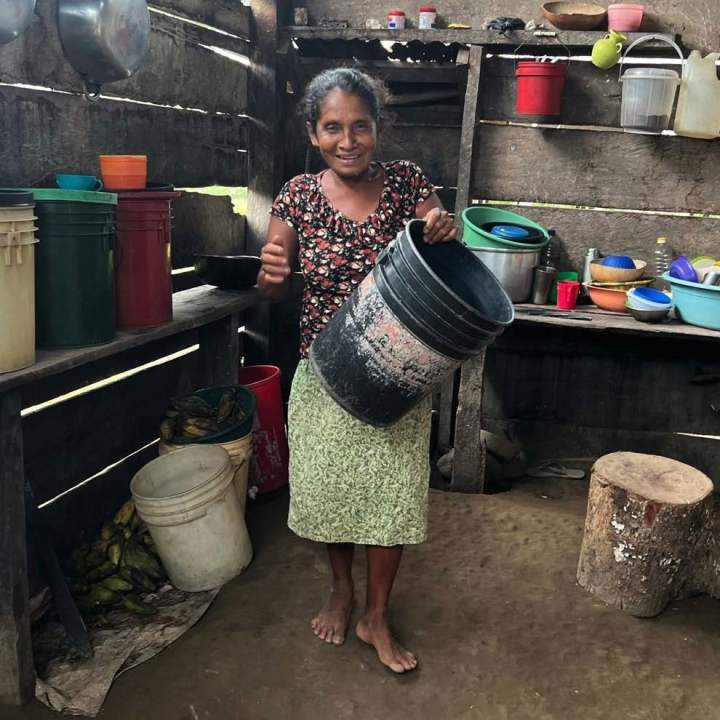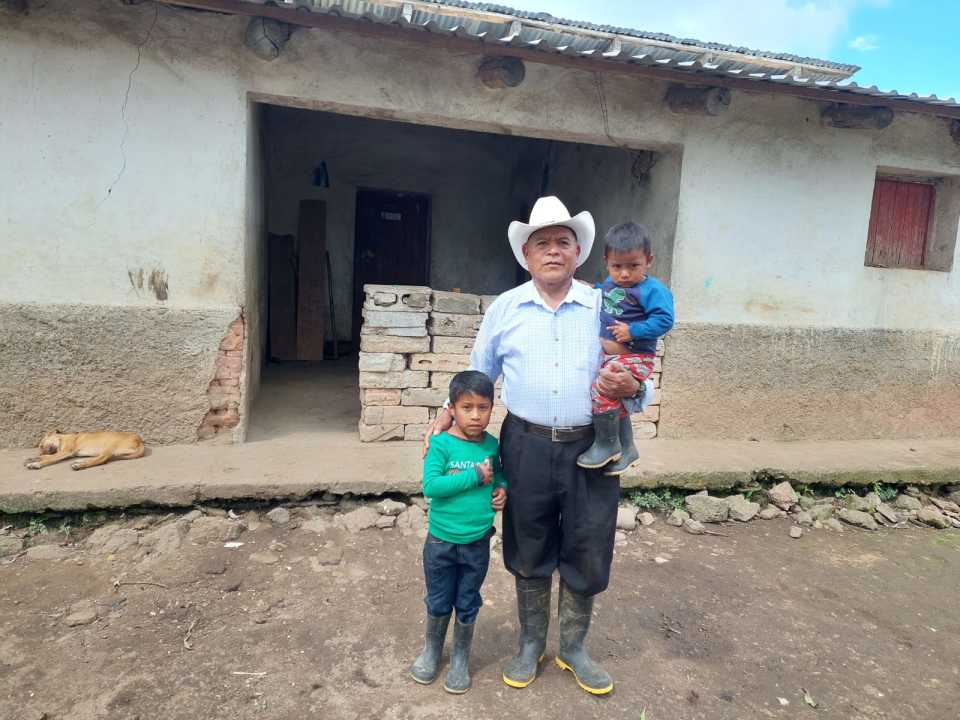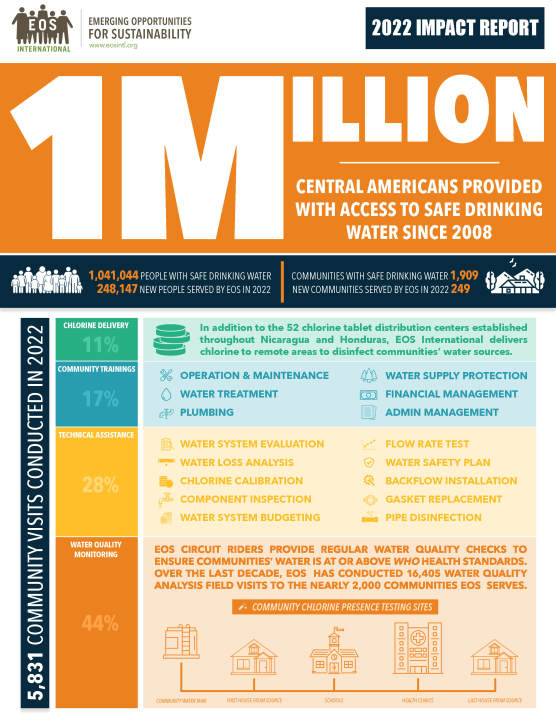Our Mission
EOS International is a nonprofit social enterprise that empowers rural families in Central America with access to safe drinking water and opportunities to generate income through simple technology solutions and education.
Donate Now
Our Impact
Honduras

Maria's daily routine involves making three arduous trips to the river to collect water for herself and her husband, Rafael. Unfortunately, their water system was devastated by a recent hurricane, leaving them with no other viable option. One of the primary objectives is the rehabilitation of Maria's community water system. This crucial step will restore access to a reliable and sustainable source of clean water for the entire community. Once the system is repaired and fully operational, Maria and her neighbors will no longer have to endure the hardship of traveling to the river multiple times a day. Additionally, EOS will install a chlorinator in the community. This will ensure that the water being supplied is properly treated, eliminating potential health risks and providing safe drinking water for Maria, Rafael, and all the residents. The chlorinator will be a significant step towards improving the overall water quality and enhancing the well-being of the entire community. Finally, EOS will build the water board capacity for local water system management. By empowering the community with the knowledge and skills required to effectively manage and maintain the water system, EOS is fostering sustainability and self-reliance. This capacity building will enable the water board to handle any future challenges and ensure the long-term success of the system. The collective efforts of EOS, community members like Maria, and dedicated individuals involved will soon bring relief and positive change to Maria's community, granting them access to a reliable, treated water supply that will greatly improve their daily lives
Dulce Nombre, Intibuca, Honduras

Don Francisco Paz, president of the water board in Dulce Nombre, Intibuca, Honduras along with Doña Sabas Mendez Director of the project. There are more than 80 families that are benefiting from high-quality, safe drinking water after the chlorinator installation. This community is primarily day labor farmers planting basic grains and harvesting coffee in season on local farms. Don Francisco Paz states that chlorination has been extremely valuable for the population since his grandchildren (age 6 and 4 pictured above) and other children in the community no longer get sick. The community as a whole is healthier since the community organized a water management board to maintain, operate, and provide long-term safe and sustainable drinking water. The water board comprises of men and women, realizing the importance of women in leadership positions. It is crucial to include women in leadership roles on the water boards as they know what effects safe water has on families; they are the caretakers of sick children and often spend hours fetching water. Doña Sabas states that now women are taken into account in the leadership of the community water and that women feel safe when preparing food for their family since they are using chlorinated water. The water board has also hired three plumbers to provide monitoring, water testing, and tank cleaning to ensure the community has continual access to safe water. Don Francisco Paz states that what he likes most about working with EOS International provides continual water quality monitoring, training, technical assistance, chlorine tests, and assistance.

EOS International 2022 Impact report
Causes We Support
Countries We Serve
United Nations Sustainable Development Goals
SDG 6: Ensure availability and sustainable management of water and sanitation for all. Clean, accessible water for all is an essential part of the world we want to live in and there is sufficient fresh water on the planet to achieve this. However, due to bad economics or poor infrastructure, millions of people including children die every day from diseases associated with inadequate water supply, sanitation and hygiene. EOS’ work will focus on the following SDG targets: SDG 6.1: By 2030, achieve universal and equitable access to safe and affordable drinking water for all. EOS targets rural populations living in poverty throughout Nicaragua and Honduras, providing water quality solutions at the community scale. We ensure that our community’s water system is operational, and that the community water board has the knowledge and resources to maintain high-quality drinking water for their community members. We also ensure that their drinking water is safe to drink, meaning free of bacterial contamination. Finally, we work closely with the water board to establish an appropriate user water bill that will cover the costs of water system operation and include a reserve for emergencies. These services improve the water for community members and align with SDG goal 6.1 6.2: By 2030, achieve access to adequate and equitable sanitation and hygiene for all and end open defecation, paying special attention to the needs of women and girls and those in vulnerable situations. Through EOS’ Circuit Riders, the water technicians provide a comprehensive approach to training, including training on the importance of proper sanitation and hygiene. EOS also works in rural schools to teach students as well as teachers on hygiene. 6.3: By 2030, improve water quality by reducing pollution, eliminating dumping and minimizing release of hazardous chemicals and materials, halving the proportion of untreated wastewater and substantially increasing recycling and safe reuse globally. A main component of EOS’ work is providing water treatment in community drinking water systems to remove harmful bacteria. This water quality work is a critical component of drinking water systems to improving and increasing the quality to a safe level for drinking. 6.4: By 2030, substantially increase water-use efficiency across all sectors and ensure sustainable withdrawals and supply of freshwater to address water scarcity and substantially reduce the number of people suffering from water scarcity. EOS works closely with community water boards to monitor the drinking water use and recommend the implementation of household metering as a strategy to monitor loss and setup a relative water user bill based on water demand. 6.5: By 2030, implement integrated water resources management at all levels, including through transboundary cooperation as appropriate. EOS works across the community, municipality, department, and national levels to integrate water resource management strategies in improving drinking water services. EOS targets their work with community water board members to improve the administration, as well as the local and national partners in the department of health to share resources, prioritize needs, align strategies. 6.6: By 2020, protect and restore water-related ecosystems, including mountains, forests, wetlands, rivers, aquifers and lakes. EOS protects water-related ecosystems through community and municipality consulting on watershed reforestation programs, specifically in the mountains of Honduras. EOS Coordinates, trains and supports local communities for the reforestation, re-development and conservation and sustainability of the water sources. 6.A: By 2030, expand international cooperation and capacity-building support to developing countries in water- and sanitation-related activities and programs, including water harvesting, desalination, water efficiency, wastewater treatment, recycling and reuse technologies. EOS participates in several national and international WASH associations and alliances to share best practices, learn about new approaches, and collaborate on program implementations. 6.B: Support and strengthen the participation of local communities in improving water and sanitation management. EOS Circuit Riders work directly with community water boards to provide capacity building, training, and technical assistance to improve the community’s drinking water systems. SDG 5: Achieve gender equality and empower women and girls. Traditionally, women are restricted from playing a pivotal role in water service delivery and only hold positions such as the treasurer or secretary on Community Water Boards due to cultural, social, and organizational limitations. EOS’ safe drinking water programming overcomes these challenges and traditions by empowering and promoting women to serve in leadership roles, including the President and Vice-President. The operations and community involvement have been superior in communities where EOS has successfully recruited women in these high leadership positions. 5.1: By 2030, end all forms of discrimination against women and girls everywhere. Social and cultural gender barriers still limit the participation of women in local governance. Our team empowers women to serve as leaders within the non-political community water boards, which serve as a local utility. The national laws do not pertain; however, our team promotes the correlation and importance of gender equality within these community water boards. 5.5: Ensure women’s full and effective participation and equal opportunities for leadership at all levels of decision-making in political, economic, and public life. Ensuring that women have an equal role in designing, managing, and monitoring community water systems can be a strategic practice that empowers women while improving safe water outcomes. Women’s involvement in decision-making about water resources and safe water programs is critical to their empowerment. Still, it is important not to overburden them with additional unpaid work on top of their existing responsibilities.[3] Gender diversity in decision-making is linked to more effective decisions within communities. Facilitating the voice of women has intrinsic value in making the women feel included and empowered and instrumental value in improving community water services and uncovering issues that may be hidden if a project only talks to the men. Women are more likely to know the difficulties of accessing safe water and the health issues in the family associated with drinking unsafe water. Without including their leadership in programs, community safe water programs may be poorly designed, operated, and maintained. Water committees with women in critical positions meet more often, demonstrate improved water system functionality, and are more effective at fee collection than committees without women in critical posts.[4] [3] Jansz, S and Wilbur, J (2013) Women and WASH. WaterAid: Briefing note [4] https://www.unicef.org/gender/files/Gender_Responsive_WASH.pdf SDG 3: Good Health and Well-being. When unsafe drinking water is not fatal, it makes families too sick to go to school or work, resulting in an underproductive workforce, high healthcare costs, and significant economic repercussions for entire communities and the country. Safe and accessible drinking water is a fundamental human right, yet one of the greatest threats to human health, responsible for over 3.4 million deaths worldwide every year, most of them children. These deaths could be avoided each year if the risk factors associated with unsafe drinking water were addressed. Permanent reduction in Waterborne Illness: Through EOS’ water quality program, independent studies have found that reported cases of waterborne diseases have been reduced by 49-61% in communities where EOS works and 73% fewer reported cases in 5–9-year-olds. SDG 13: Climate Action. Water-related impacts of climate change have adverse effects on food security, health, and the daily livelihoods of the world’s most vulnerable individuals. Climate change is one of the greatest global challenges of the twenty-first century. Its impacts vary among regions, generations, ages, classes, income groups, and gender. Based on the findings of the Intergovernmental Panel on Climate Change (IPCC), it is evident that people who are already most vulnerable and marginalized will also experience the greatest impacts. The poor, primarily in developing countries, are expected to be disproportionately affected and consequently in the greatest need of adaptation strategies in the face of climate variability and change. Women are increasingly being seen as more vulnerable than men to the impacts of climate change, mainly because they represent the majority of the world’s poor and are proportionally more dependent on threatened natural resources. The difference between men and women can also be seen in their differential roles, responsibilities, decision-making, access to land and natural resources, opportunities, and needs, which are held by both sexes. Worldwide, women have less access than men to resources such as land, credit, agricultural inputs, decision-making structures, technology, training, and extension services that would enhance their capacity to adapt to climate change. SDG 15: Protect, restore, and promote sustainable use of terrestrial ecosystems and forests. Deforestation is happening at an alarming rate in Central America due to the increased area of agricultural lands, and slash and burn methods of farming practices. One of the root causes of deforestation is the pursuit of better economic opportunities. Deforestation is one of the largest contributors to climate change. Despite the benefits of a healthy forest, restoration is not being implemented at the pace and scale required. This deforestation has direct effects on the quality of community drinking water systems, introducing new contaminants into the water source. Forests and water are essential resources that provide many socioeconomic advantages and services to communities and the environment. Forested watersheds offer high-quality water.[5] Ecological-forest restoration increases the water supply, directly improving drinking water quality and restoring native habitats. Forest restoration increases the resilience of the communities that rely on the benefits of forests – including clean water. [5] FAO, “Managing forests for cleaner water for urban populations,” Stolton, S. and Dudley, N. (ed), Unasylva 229, Vol. 58, 2007.